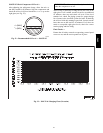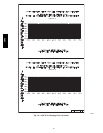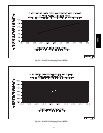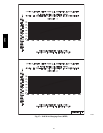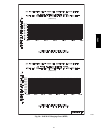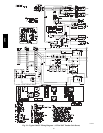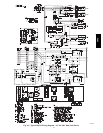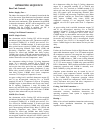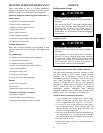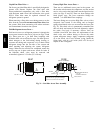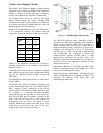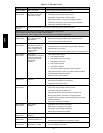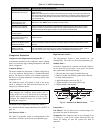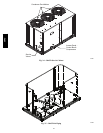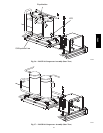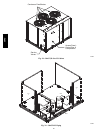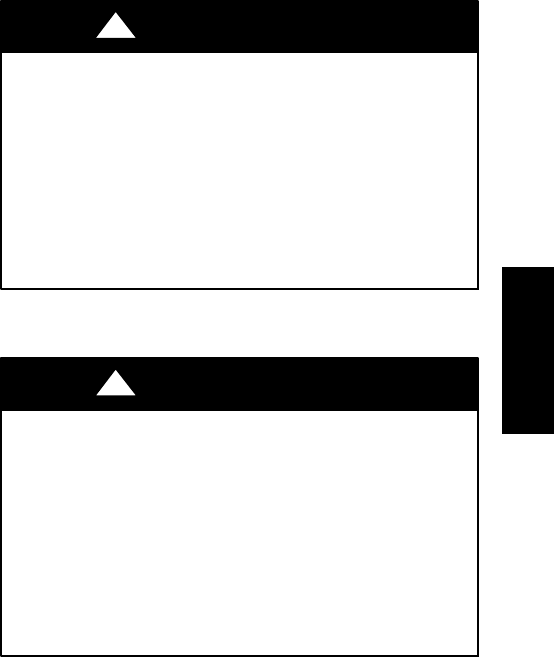
33
ROUTINE SYSTEM MAINTENANCE
These items should be part of a routine maintenance
program, to be checked every month or two, until a specific
schedule for each can be identified for this installation:
Quarterly Inspection (and 30 days after initial start) —
Indoor section
S Condenser coil cleanliness checked.
S Return air filter replacement
S Outdoor hood inlet filters cleaned
S Belt tension checked
S Belt condition checked
S Pulley alignment checked
S Fan shaft bearing locking collar tightness checked
S Condensate drain checked
Seasonal Maintenance —
These items should be checked at the beginning of each
season (or more often if local conditions and usage patterns
dictate):
Air Conditioning
S Condenser fan motor mounting bolts tightness
S Compressor mounting bolts
S Condenser fan blade positioning
S Control box cleanliness and wiring condition
S Wire terminal tightness
S Refrigerant charge level
S Evaporator coil cleaning
S Evaporator blower motor amperage
Heating
S Power wire connections
S Fuses ready
S Manual-reset limit switch is closed
Economizer or Outside Air Damper
S Inlet filters condition
S Check damper travel (economizer)
S Check gear and dampers for debris and dirt
SERVICE
Refrigeration System
EQUIPMENT DAMAGE HAZARD
Failure to follow this caution may result in damage to
equipment.
This system uses Puron
R
refrigerant which has higher
pressures than R-22 and other refrigerants. No other
refrigerant may be used in this system. Gage set,
hoses, and recovery system must be designed to
handle Puron. If you are unsure consult the equipment
manufacturer.
CAUTION
!
Compressor Oil —
EQUIPMENT DAMAGE HAZARD
Failure to follow this caution may result in damage to
equipment.
The compressor in a Puron system uses a polyolester
(POE) oil. This oil is extremely hygroscopic, meaning
it absorbs water readily. POE oils can absorb 15 times
as much water as other oils designed for HCFC and
CFC refrigerants. Take all necessary precautions to
avoid exposure of the oil to the atmosphere.
CAUTION
!
Servicing Systems on Roofs With Synthetic Materials —
POE (polyolester) compressor lubricants are known to cause
long term damage to some synthetic roofing materials.
Exposure, even if immediately cleaned up, may cause
embrittlement (leading to cracking) to occur in one year or
more. When performing any service which may risk
exposure of compressor oil to the roof, take appropriate
precautions to protect roofing. Procedures which risk oil
leakage include but are not limited to compressor
replacement, repairing refrigerants leaks, replacing
refrigerant components such as filter drier, pressure switch,
metering device, coil, accumulator, or reversing valve.
Synthetic Roof Precautionary Procedure:
1. Cover extended roof working area with an imper-
meable polyethylene (plastic) drop cloth or tarp.
Cover an approximate 10 x 10 ft (3.3 x 3.3 m) area.
2. Cover area in front of the unit service panel with a
terry cloth shop towel to absorb lubricant spills and
prevent run-offs, and protect drop cloth from tears
caused by tools or components.
3. Place terry cloth shop towel inside unit immediately un-
der component(s) to be serviced and prevent lubricant
run-offs through the louvered openings in the base pan.
4. Perform required service.
5. Remove and dispose of any oil contaminated material
per local codes.
38AU



